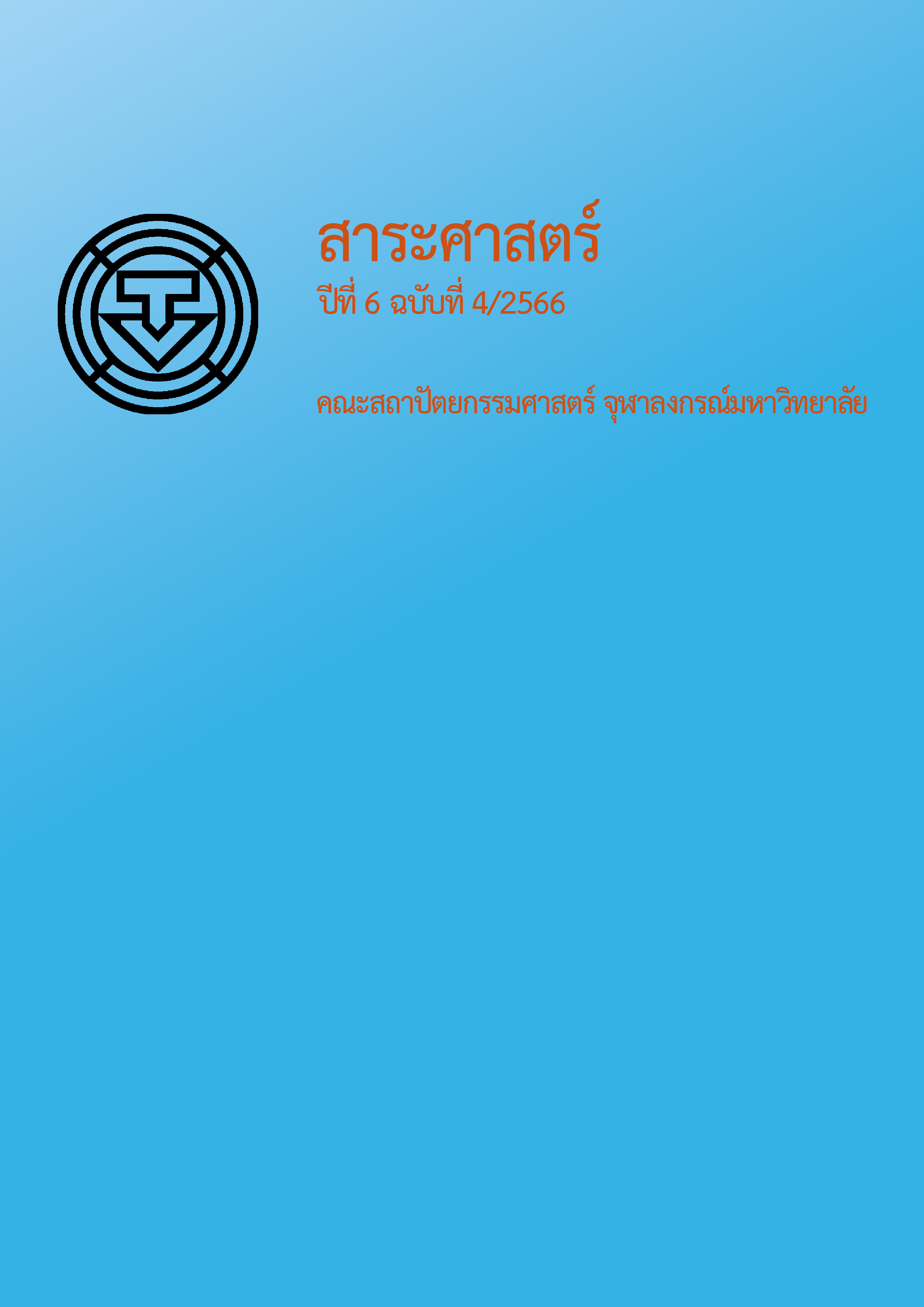Relationship Between Housing and Workplace of Residents in Bang Plee New Town, Samut Prakarn Province
Main Article Content
Abstract
Bang Plee New Town established by the National Housing Authority in 1980 with the objective of supporting the expansion of Bangkok. This innovative project operated under the visionary concept of creating a self-contained new town. With the primary aim to commute long distances to work in the crowded metropolis of Bangkok. The target was to have at least 50 percent of the residents gainfully employed within Bang Plee New Town. To study the living conditions and job sources of residents in the city. The core purpose of the article is to study the characteristics of residences and the location of employment sources. The commuting behaviors of the city's residents. To analyze the relationship between housing and workplace of the residence in Bang Plee New Town. The relationship between different type of housing and the location of employment sources. Currently, its 35,631 residential units. A total of 411 sets of questionnaires serves as the primary tool for data collection.
The study's findings that the sample of residents in Bang Plee New Town exhibited a diverse income distribution, with 35.2% belonging to low-income households, 39.4% into the middle-income, and 25.3% categorized as high-income households. The low-income households tended to have smaller household sizes, typically consisting of 1-2 individuals. In contrast, middle- and high-income households had larger households, with 3-5 people residing together. A significant majority, approximately 72.5% of the residents, opted to live in flats and apartments. with ownership rights in the rental of 56.5% A substantial 83.6% of Bang Plee New Town residents found employment within the new city itself. The top job sectors included 38.0% in sales roles, 26.1% as factory workers, and 23.5% working for private companies. Most residents 35.6% had work locations within 1 kilometer from their homes. Remarkably, 58.1% didn't need to travel more than 1 kilometer, and 37.0% chose to commute by motorcycle. This proximity resulted in a considerable number of residents not exceeding 30 minutes in their daily commute. A significant portion of residents 29.2% reported monthly travel expenses ranging from 500-1,200 baht.
The close proximity of homes to workplaces contributed to cost and time savings in commuting. The study serves as a compelling reference and instructive case study for private sector stakeholders interested in land or housing development initiatives. They underscore the paramount importance of integrating a fundamental principle: achieving a harmonious balance between residential living and accessible employment opportunities, commonly referred to as the "Jobs-Housing Balance." Furthermore, the concept of establishing self-sustaining new towns, where residents can conveniently access both residential and occupational amenities within a single community, emerges as a pivotal facet of successful development.
Article Details
References
กระทรวงการพัฒนาสังคมและความมั่นคงของมนุษย์. การเคหะแห่งชาติ. คณะทำงานจัดทำผังแม่บทโครงการเมืองใหม่บางพลี. (ม.ป.ป.). ผังแม่บทโครงการเมืองใหม่บางพลี. กคช.
กองบริหารโครงการเชิงพาณิชย์ 3. ฝ่ายพัฒนาโครงการเชิงพาณิชย์. (2561). โครงการเคหะชุมชนและบริการชุมชนหารายได้ บางพลีทาวน์โฮม 2. การเคหะแห่งชาติ.
กองฟื้นฟูเมืองและจัดรูปที่ดิน. ฝ่ายวิชาการพัฒนาที่อยู่อาศัย. (2558). การศึกษาและคัดเลือกพื้นที่เพื่อนำมาพัฒนาเมืองใหม่.
การเคหะแห่งชาติ. (2561). ผลสำรวจการเก็บข้อมูลภาคการเคหะในประเทศไทยใหม่ รายงานฉบับสมบูรณ์ พฤษภาคม 2561. การเคหะแห่งชาติ.
การนิคมอุตสาหกรรมแห่งประเทศไทย [กนอ.]. (ม.ป.ป.). จำนวนโรงงานในนิคมอุตสาหกรรมเมืองใหม่บางพลี. https://www.ieat.go.th/online-service/industrial-list/g628
วรชาติ แก้วคำฟู. (2543). พัฒนาการของการต่อเติมที่อยู่อาศัยแบบสร้างบางส่วน กรณีศึกษา : ที่อยู่อาศัยแบบ A ในโครงการเมืองใหม่บางพลี สมุทรปราการ [วิทยานิพนธ์ปริญญามหาบัณฑิต ไม่ได้ตีพิมพ์]. จุฬาลงกรณ์มหาวิทยาลัย.
สายธาร หนูเกลี้ยง และยุวดี ศิริ. (2563). ความสัมพันธ์ระหว่างที่อยู่อาศัยกับแหล่งงาน : กรณีศึกษา กระทรวงสาธารณสุช จังหวัดนนทบุรี. สาระศาสตร์, (4), 895.
Afrakhteh, H. (2003). Urban growth and experience of new town planning in the developing countries: A case study of Tehran Metropolis. Urban Planning Overseas, 18, 5–9.
Brown, N. (2011). Robert Park and Ernest Burgess: Urban ecology studies, 1925. Center for Spatially Integrated Social Science.
Cervero, R. (1989). Jobs – housing balancing and regional mobility. Journal of the American Planning Association, 55(2), 136-150.
Giuliano, G. (1991). Is jobs-housing balance a transportation issue? The University of California Transportation Center.
Hazel, E. (1972). In new towns: The British experience. C. Knight for the Town and Country Planning Association.
Howard, E. (1902). To-morrow: A peaceful path to real reform. S. Sonnenschein & Co., Ltd.
Lean, W. & Goodal, B. (1966). Aspects of land economics. Estates Gazette.
McKenzie, R. D., Park, R. E., & Burgess, E. W. (1967). The city (Vol. 239). University of Chicago Press.
Moriarty, Barry M. (1975). Population and employment shifts within regional hierarchies of cities. The Association of American Geographers.
Nattapol Chawalitcheevin, Supachai Sophasatianbongsa, & Uraivarn Utaipatanacheep. (1959). Labour absorption at Bang Plee new town. (N.p.).
Wingo, L. (1969). Latin American urbanization: Plan or process? Resources for the Future.


